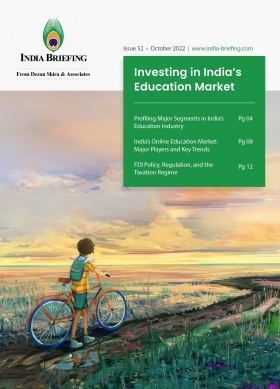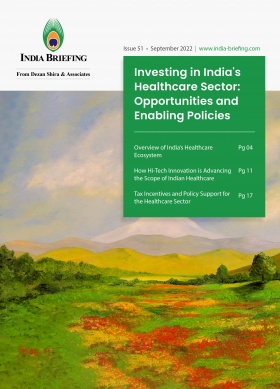Exploring India’s Thriving OTT Video Segment: Trends, Growth, and Investor Interest
The pandemic-induced lockdowns that forced millions of Indians to stay indoors have led to a significant surge in the demand for online video content. As a result, India’s OTT media services sector is experiencing rapid growth, including the rising consumption of international content either in English or in dubbed language versions. Meanwhile, the user penetration rate for OTT video in India is expected to increase from 30 percent to 36 percent between 2023 and 2027 and the average revenue per user (ARPU) in the OTT video segment is projected to reach US$8.81 in 2023. Another challenger to traditional content consumption, the short-form video, is capturing more Indian viewers than ever before – comparable to global trends – and is influencing company strategies around brand marketing and online commerce.
A nascent market that is fiercely competitive
Over-the-top (OTT) media platforms are in fierce competition for the Indian consumers’ attention, and one of the key drivers of growth and differentiation is the creation of high-quality, original content.
To stay ahead in the game, industry players are investing heavily in the development of content and services, as well as in improving the customer experience.
With its diverse culture and a large audience eager for entertainment, India currently boasts of around 40 OTT platforms. Each OTT platform in India has its own subscription pricing model and some even offer free trials for a period to new users.
Aggressive tactics, such as relatively new market entrant JioCinema streaming free matches of hugely popular sporting tournaments like the FIFA World Cup 2022 and the Indian Premier League (IPL) are further likely to familiarize more Indians with consuming content on OTT platforms. In fact, JioCinema reported 1.47 billion views on the opening weekend of the 2023 IPL.
Market valuation and growth projection to 2030
Based on Statista’s data, the OTT video user penetration rate in India is predicted to rise from 30 percent to 36 percent between 2023 and 2027. Furthermore, the OTT video segment’s average revenue per user (ARPU) is estimated to reach US$8.81 in 2023.
In the fiscal year 2021-22, India’s video OTT market was valued at INR 249.09 billion (US$2.92 billion). The market is anticipated to expand at a CAGR of about 16.58 percent from FY 2023 to FY 2027, reaching a value of INR 581.21 billion (over US$7 billion).
As per a CII-BCG report called ‘Shaping the Future of Indian M&E’ released in November 2022, the Indian OTT market could grow at a CAGR of 20-23 percent from 2022 to 2030. It could be worth around US$11-13 billion by the end of this decade. The study revealed that by 2030, subscription video-on-demand (SVoD) platforms could account for 55-60 percent of India’s overall OTT revenue, surpassing advertising-driven platforms, which would constitute 40-45 percent of the market share.
Key drivers of growth
The OTT industry accounts for 7-9 percent of the entertainment industry and owes much of its growth to the increasing popularity of short-form content and the affordability of data plans in India.
Low cost data and greater internet access
As per an affordability index put out by Surfshark, a Netherlands-based cybersecurity services firm, India was ranked 44th out of 117 countries in 2022, moving up three places from 2021. The average monthly bill for a fixed broadband internet package in India comes to US$15.60, while a 2GB mobile broadband package can cost under US$2.50 for a 28-day period (inclusive of other benefits). Several internet providers bundle OTT-access as part of their data plans, especially among higher packages (for example, a 3 month-Disney+Hotstar offering on an Airtel prepaid recharge of about US$10.22 that is valid for 84 days).
India has over 600 million smartphone users and there are over 837 million internet users in the country. A GroupM-Kantar study reported that about 20 to 22 million homes had internet-enabled connected televisions, which is a tenth of Indian television households. There were over 800 million broadband users in India at the end of 2022. The population using broadband for social media, video, or entertainment is around 485 million.
Monetization of short-form content
There is a possibility of generating US$8-12 billion through monetization of short-form video (SFV) content in India by 2030, as per a report by firm Redseer Strategy Consultants. The preferred language of content consumption in India metropolitan and tier-2 cities on SFV apps is Hindi followed by English and other regional languages.
There is a huge demand for fresh content ‘anytime-anywhere’, and attention spans are also reducing. The SFV format is scroll-friendly and viewers/users do not suffer from decision fatigue, such as when confronted with a vast OTT content library.
The need for constant and quick audio-visual stimulation has in turn facilitated the diversified growth of a creator economy where cultural nuance, regional languages, and relatable content across various formats from music and dance to dialog and acting to stand-up comedy is increasingly entertaining more Indians – comparable to global market trends. This is also producing opportunities for brands and advertisers to connect with consumers.
Tier-2 cities are driving India’s appetite for SFV content, forming over 60 percent of the user base of such apps. About 40 percent of the users are in the age group 16-24 years, according to a report by the Boston Consulting Group.
Influencer marketing and virtual gifting
Influencer marketing is becoming an increasingly important strategy for several brands, with spending on influencers projected to grow from US$0.33-0.4 billion at present to US$2.8-3.5 billion by 2028.
Short-form videos account for about 7-10 percent of the overall time spent on content in the country. Brand ads conversion via influencers is high in India and fashion is the most popular segment. The Redseer report also predicts that virtual gifting on SFV platforms in India could be worth US$1.7 billion by 2030.
Amazon, the parent company of Amazon Prime, is among those seeking to tap the rapidly growing short-form video preference among Indians. While it uses video commerce on its online shopping app to promote customer engagement and boost sales, the firm also provides what it calls miniTV, a free OTT service available on Amazon Shopping.
Spending by OTT players in India
According to findings in “OTT (Over-the-top) Market in India 2022-2027”, a report by Research And Markets, in FY 2021, the total investment in OTT platforms in India was estimated to be INR 55.21 billion (US$672.59 million), with Netflix, Amazon Prime Video, and Disney+ Hotstar being the top spenders, with a combined expenditure of INR 31.55 billion (US$384.35 million).
In 2022, market estimates showed that leading OTT platforms invested heavily on original content production – spending between US$600-700 million (excluding movie and sports content).
Last April, Amazon announced that it would launch more than 40 new series and movies in regional languages Hindi, Tamil, and Telegu. Netflix has spent US$400 million on content in 2019 and 2020 and SonyLIV is working on a spate of original content and regional language titles in 2023.
Overall, as per Media Partners Asia, the estimated online video content investment in India in 2022 was about US$1.3 billion and is projected to reach US$4.2 billion by 2027.
Growing appetite for international content
A report commissioned by Sony Pictures Television (SPT) found that English language content no longer occupies a niche segment in the Indian market. The study was based on surveys and research conducted across major metropolitan cities in India, including Mumbai, Delhi, Bengaluru, Hyderabad, Ahmedabad, Chennai, Kolkata, and Pune and focused on individuals above the age of 15.
Media consulting firm Ormax noted in the report that the number of Indians watching international English content skyrocketed from 19.1 million before the pandemic to over 85 million presently, reflecting a 124 percent increase. Out of this total, 42.7 million are paying subscribers of SVoD services, while 42.5 million watch AVoD (advertising video-on-demand).
Ormax reported that 65 percent of urban Indian SVoD audiences consumed English content, and were spread across metropolitan cities, smaller cities, and towns.
The availability of dubbed versions of popular international shows on OTT platforms, which were not originally available on English-language satellite TV channels in India, has significantly increased viewership. This was particularly evident during the pandemic, when Indian audiences became more open to trying new content and were influenced by their virality on social media.
Dubbing and subtitles have also facilitated increased consumption of content in other foreign languages as well.
A prime example is the massive popularity of Korean content traced to the pandemic lockdowns, which has resulted in OTT platforms like Netflix showcasing a wide variety of Korean dramas, reality shows, and movies on its India app. Last year, Business Today reported that regional player, Aha (a Telegu-OTT platform), had entered into a partnership with Hong Kong-based 04 Media to “stream over 100 hours of K-dramas, films, and music to its 50 million-plus viewers.”
Cross-platform promotion
The promotion of streaming content on digital platforms with vast user bases like YouTube and Instagram has also boosted awareness among Indian viewers, who then tailor their subscription choices over short periods of time or annually.
OTT giants like Netflix freely engage with prospective users on popular short-form video platforms, especially around upcoming content, latest viewership trends, or viral topics on social media through interviews, content clips, variety entertainment with cast members of streaming titles, and color commentary by popular social media influencers and entertainers. This in turn builds up the platform’s brand appeal in the market.
OTT players in India
As of October 1, 2022, Disney+Hotstar had approximately 61.3 million subscribers, which dropped to reach around 57.5 million as per current estimates. The end of the platform’s content partnership with HBO on March 31 this year and loss of IPL 2023 streaming rights to JioCinema may further the declining trend.
Analysis from consultancy firm Arthur D Little shows that Netflix currently has 6.1 million subscribers in India while Amazon Prime Video has 22.3 million. The firm puts Disney+Hotstar’s subscriber base at 51 million.
|
Leading OTT Platforms in India and Their Language Offerings |
|||
|
OTT platform |
Parent company |
Years active |
Languages |
|
Aha |
Arha Media & Broadcasting Pvt. Ltd. |
2020-present |
Telegu, Tamil |
|
Amazon Prime Video |
Amazon |
2016-present |
Marathi, English, Hindi, Tamil, Telugu, Bengali, Malayalam, Kannada, Odia, Punjabi, Gujarati |
|
Apple TV+ |
Apple Inc |
2019–present |
English, Hindi |
|
Arre |
UDigital |
2015– present |
Hindi, English |
|
Crunchyroll |
Sony |
2006–present |
English, Chinese, Arabic, Hindi, Castillian, Italian, Japanese, Spanish, Portuguese, German, French and Russian |
|
Discovery+ |
Warner Bros. Discovery |
2020–present |
Hindi, English, Tamil, Telugu, Malayalam, Kannada, Bengali and Marathi |
|
Disney+ Hotstar |
Star India (The Walt Disney Company India) |
2015–present |
Hindi, English, Tamil, Marathi, Telugu, Malayalam, Bengali, Kannada, |
|
Eros Now |
Eros International |
2015–present |
Hindi, Bengali, Marathi, Tamil, Telugu, Punjabi |
|
Hayu |
NBCUniversal |
2016–present |
English |
|
Hungama Play |
Hungama Digital Media Entertainment |
2015–present |
Bhojpuri, Hindi, English, Tamil, Telugu |
|
JioTV |
Jio Platforms |
2016–present |
Assamese, Bengali, Bhojpuri, English, French, Gujarati, Hindi, Kannada, Malayalam, Marathi, Nepali, Odia, Punjabi, Tamil, Telugu, Urdu |
|
JioCinema |
Jio Platforms |
2016–present |
English, Hindi, Tamil, Marathi, Telugu, Bengali, Malayalam, Kannada, Odia, Punjabi, Gujarati |
|
Lionsgate Play |
Lionsgate |
2020–present |
English, Hindi, Tamil, Telugu, Marathi, Bengali, Kannada, Malayalam |
|
MX Player |
Times Internet |
2018–present |
Bhojpuri, Hindi, Tamil, Telugu, Marathi, Bengali, Malayalam, Kannada, Punjabi, Odia, Gujarati, English |
|
Mubi |
Mubi Inc. |
2019–present |
English, Hindi, Tamil, Marathi, Telugu, Bengali, Malayalam, Kannada |
|
Netflix |
Netflix Inc. |
2015–present |
English, Hindi, Tamil, Marathi, Telugu, Bengali, Malayalam, Kannada |
|
SonyLIV |
Culver Max Entertainment |
2013–present |
Hindi, Telugu, English, Tamil, Marathi, Bengali, Malayalam, Kannada, Punjabi |
|
TVFPlay |
Contagious Online Media Network Private Limited |
2015–present |
Hindi, Tamil, Telugu |
|
Viki |
Rakuten |
2010–present |
English |
|
Voot |
Viacom 18 |
2016–present |
English, Hindi, Telugu, Tamil, Marathi, Bengali, Malayalam, Kannada, Odia, Punjabi, Gujarati |
|
ZEE5 |
Zee Entertainment Enterprises |
2018–present |
Bhojpuri, Hindi, Tamil, Telugu, Marathi, Bengali, Malayalam, Kannada, Punjabi, Odia, Gujarati, English |
Key takeaways
To summarize, the lockdowns caused by the pandemic have resulted in a substantial rise in the demand for OTT streaming video services in India, leading to rapid growth in the OTT media services sector.
Companies, both homegrown and global OTT giants, are fiercely competing for greater market share by investing heavily in producing top-notch, original content and enhancing the customer experience.
Growth of the Indian OTT market is primarily driven by affordable data plans in India and the growing popularity of short-form content, especially among tier-2 city users and young consumers. As a result, monetizing short-form video content is predicted to yield up to US$12 billion by 2030.
Lastly, the demand for constant and instant audio-visual gratification has led to the emergence of a diverse creator economy, which is not only entertaining more Indians but also generating niche and localized opportunities for brands and advertisers to engage with consumers and achieve deeper market penetration.
About Us
India Briefing is produced by Dezan Shira & Associates. The firm assists foreign investors throughout Asia from offices across the world, including in Delhi and Mumbai. Readers may write to india@dezshira.com for more support on doing business in in India.
We also maintain offices or have alliance partners assisting foreign investors in Indonesia, Singapore, Vietnam, Philippines, Malaysia, Thailand, Italy, Germany, and the United States, in addition to practices in Bangladesh and Russia.
- Previous Article India’s PLI Scheme for Textiles: 64 Beneficiaries Approved
- Next Article Apple Official Stores Open in India as Suppliers Scale Up Production Capacity










